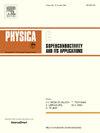Effect of chemical etching of copper stabilization layer on the performance and microstructure of REBa2Cu3O7-x coated conductors
IF 1
3区 物理与天体物理
Q4 PHYSICS, APPLIED
Physica C-superconductivity and Its Applications
Pub Date : 2025-06-02
DOI:10.1016/j.physc.2025.1354715
引用次数: 0
Abstract
The etching of metallic layers is a critical step in the preparation of superconducting joints and in the study of the degradation mechanism of the superconducting performance of REBa2Cu3O7-x (REBCO) coated conductors (CCs). The copper stabilization layer and the silver cap layer need to be completely removed from the specified area and retain excellent superconductivity and microstructure. Since REBCO CCs are sensitive to most inorganic solutions, the etching conditions can severely affect the performance and microstructure when using a wet etching process. We have systematically investigated the effects of ferric chloride (FeCl3) solutions on the crystal structure, microscopic morphology, critical current (Ic) and n-values of REBCO CCs when etching copper stabilization layers, and have obtained etching parameters that hardly degrade Ic of CCs. However, when the etching conditions were varied, we found a significant degradation of Ic and investigated the underlying causes of this degradation. Scanning electron microscopy (SEM), Raman spectroscopy and X-ray diffraction (XRD) analyses showed that the main cause of the superconducting performance degradation is the delamination of the superconducting layer and the increase of oxygen defects in the lattice.
化学蚀刻铜稳定层对REBa2Cu3O7-x涂层导体性能和微观结构的影响
金属层的刻蚀是制备超导接头和研究REBa2Cu3O7-x (REBCO)涂层导体(CCs)超导性能退化机理的关键步骤。铜稳定层和银帽层需要从指定区域完全去除,并保持优异的超导性和微观结构。由于REBCO cc对大多数无机溶液敏感,因此采用湿法蚀刻工艺时,蚀刻条件会严重影响其性能和微观结构。我们系统地研究了氯化铁(FeCl3)溶液在刻蚀铜稳定层时对REBCO cc晶体结构、微观形貌、临界电流(Ic)和n值的影响,并获得了几乎不会降解cc Ic的刻蚀参数。然而,当蚀刻条件发生变化时,我们发现了Ic的显著降解,并研究了这种降解的根本原因。扫描电镜(SEM)、拉曼光谱(Raman)和x射线衍射(XRD)分析表明,导致超导性能下降的主要原因是超导层的分层和晶格中氧缺陷的增加。
本文章由计算机程序翻译,如有差异,请以英文原文为准。
求助全文
约1分钟内获得全文
求助全文
来源期刊
CiteScore
2.70
自引率
11.80%
发文量
102
审稿时长
66 days
期刊介绍:
Physica C (Superconductivity and its Applications) publishes peer-reviewed papers on novel developments in the field of superconductivity. Topics include discovery of new superconducting materials and elucidation of their mechanisms, physics of vortex matter, enhancement of critical properties of superconductors, identification of novel properties and processing methods that improve their performance and promote new routes to applications of superconductivity.
The main goal of the journal is to publish:
1. Papers that substantially increase the understanding of the fundamental aspects and mechanisms of superconductivity and vortex matter through theoretical and experimental methods.
2. Papers that report on novel physical properties and processing of materials that substantially enhance their critical performance.
3. Papers that promote new or improved routes to applications of superconductivity and/or superconducting materials, and proof-of-concept novel proto-type superconducting devices.
The editors of the journal will select papers that are well written and based on thorough research that provide truly novel insights.

 求助内容:
求助内容: 应助结果提醒方式:
应助结果提醒方式:


